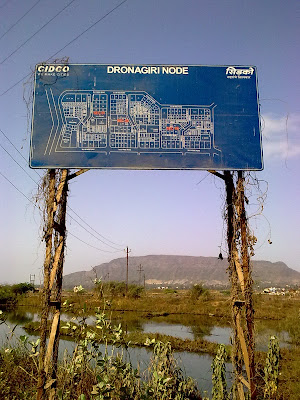
across the harbor on the mainland the southernmost node of new bombay stands on the threshold of development. older villages whose land had been acquired by the state for the city stand surrounded by special economic zones. the land acquired by the state has been handed over to reliance to develop an information technology hub and the same expands further south as another future city called maha mumbai eats into pen (see an earlier post). another special economic zone is emerging around the jnpt. even more new ports emerge further along the coast and are connected by high speed roads. one being a road from mumbai to uran which would cut down the drive from the heart of the city to here by 2 hours. the proposed airport at ulwe is also 20 minutes away.
i was documenting this land almost 10 years back for a publication on new bombay that never saw the light of day. the landscape hasn’t changed much in that time in spite of all he speculations and proposals that haunt it. the only visible changes seen are large fields of container yards with red, brown boxes piled on top of one another. the hills have been mined indiscriminately and in the special economic zone grey precast concrete walls separate the public from the private.
within the walls nothing much is different though. land is being consolidated for construction, tractors lie waiting, in one place low lying lands are filled in, while in others mangroves take over what was once agricultural land. meanwhile the villages watch dumbfounded at the ghosts of development that surround them. speculations are rife about the future and how villagers can capitalize on it. there are brokers hired from the locals to strike deals with villagers whose land is being bought. 12.5% of the land that cidco acquired was to be given back to the villagers fro development. this land is about to be released. so it has been said. while some villagers want to consolidate this land and create a company for themselves, others see short term profits and sell the land off as soon as they can. this sudden windfall is squandered away on lavish weddings and enormous houses.trained by a idealistic vision of simpler villagers who have almost an umbilical cord attaching them to the land, we find it difficult to understand this.
some of the villagers try to convince those looking at this material gain on a short term with other dreams of a more profitable and brighter future. isn't this is the way cities grow? automatically the new has a dynamism and a drive which the older and the settled suspect. trained by centuries of sedentary living they have no tools by which they can deal with the complexity of urbanism. the city will exploit them. but in many ways they will also grow because of the encounter. the possible consequences that might result from this meeting must be carefully understood before we step in with our romanticism about an underdog (because he is not really quite as naive as we might want him to be) or worship for a development which can erase everything that currently exists (including the people we claim to be developing)




No comments:
Post a Comment